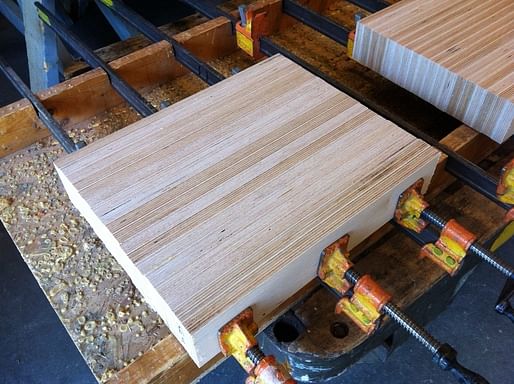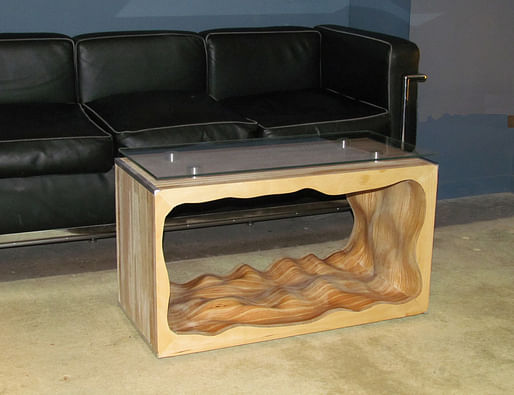
In my last post I showcased some of the work done this semester in my "Architecture of Objects" course led by Professor Shaun Jackson. I am sure everyone who checked it out would agree there were some really awesome lights and furniture pieces in this year's showcase.
This post will give a closer look at my final piece for the course, a coffee table prototype which arose from the desire to create an object with radically different interior and exterior relationships. The exterior of the table is very geometrically precise with straight lines and hard edges. The interior, on the other hand, allows for a loosening of the geometry and results in a free-formed and undulating surface.

The table is made from laminated strips of birch plywood which are then CNC routed based on a Rhino software model to create the interior geometry. After the four sides are cut on the CNC, they are sanded to create a smooth surface and attached together.
Here is a video we taped while CNC routing.... (http://bit.ly/K792Fi)
Brandon Vieth was a CNC master and helped with all the routing work.




The 1/4" glass top is custom ordered and fabricated from a local fabricator and is held 1" above the top surface of the table by (4) aluminum pieces which were cut from a single length of aluminum and then finished in the school's woodshop and fabrication studio. There are also (4) more on the bottom of the table that act as the table's feet. These eight aluminum pieces fit into pre-cut 1/2" deep holes in the table's top and bottom which were done before CNC routing.


The edges where the miter joints meet is concealed with an aluminum channel cut to length in the school's woodshop. These pieces serve to accent and compliment the aluminum pieces holding up the glass table top.



I am a graduate student and an entrepreneur at the University of Michigan Taubman College where my studies are focused on leveraging design ideas across multiple scales and platforms. Meeting at the intersection between design, tectonics and fabrication, I am continually exploring how a design idea can navigate complex material and production systems and evolve into fully realized architectural artifacts.
11 Comments
beautiful and inspiring work!! I've been thinking about laminating wood.. was wondering if you could tell me what you used to laminate and the process? I have a hard time believing wood will hold well with glue xD
The work from this class is very nice. Amazing it was done in a semester. One question though, Why the glass top on the table? It seems extemporaneous to the design. all this work put into the body and then it just becomes glorified legs. If a glass top was needed, why not embed it into the top. then it becomes part of the fantastic base and highlights the lamination. just a thought. I have never built a table so there could me much I am missing about the design process. nice work.
Accesskb:
Thanks for the kind words and I am pumped you liked the table. For these plywood pieces I did actually only use wood glue and then made sure to keep them clamped together until the glue completely dried. Once the glue is dry it is actually pretty solid. If you are laminating thinner strips of maybe one-ply then you would usually use a different process involving something called contact cement, which is what is used to laminate countertops.
Matthew:
Again thanks for the comments. The question of the relevency of the glass top is actually something that has come up a number of times. My only real answer is that I wanted to experiment with several different materials within the design. The glass top allowed for not only a glass finish element, which I was hoping would give it more mass appeal, but it also allowed me to fabricate the metal elements to hold up the glass.
I am planning another table which will be similar but I might remove the plywood top and allow for the glass to become the only top element.
The milling is interesting, for the moment. But the glass top is unnecessary and detracts from the main point of the project. If the whole thing was milled out of glass, that might marry the best of both worlds.
How was the "loose geometry" (your term) determined? Did you start with a topo map or scan a curve from nature or something (I had a buddy who did a plaster cast of his girlfriend's hip and used it for a piece of furniture once)?
i don't mind the glass per se, but i mind the gap between the glass and the wood. dust will accumulate and it'll be difficult to clean.
also, i don't see how the bottom part of the interior geometry is utilized. typically, having a hollow stand makes for a place to stack magazines or ..well, something. how do the resultant waves accomodate the envisaged objects? take a picture with a couple of books there...or have you something in mind?
i'm not sure i like the corner mitred intersections. they seem more of the result of thinking of attaching the surfaces than the result of thinking of the overall finesse of a fine pice of furniture/
that reflects back in the line seperating the vertical wavey surface from that of the horizontal on the inside seperating the wavey surfaces. i think a more sensitive joint would have served the design better.
i think if you apply nice varnish on the smooth and flat outer surfaces of the table to aid in the contrast with inner shenanigans, this will give it more refinement.
actually, and this is my opinion, i think that it would have been more evocative to turn the whole thing inside out. inside flat, outside wavey. then the glass surface would make more sense as a flat surface fixed on top of a less functionally feasible wavey surface...and the inside geometry of the table would be flat, thus more functionally feasible. this would also have lessened that deadening and muting effect of facing the blank outer "walls" of the table you designed. unless you started thinking of interior shelving effects and how that could interface with the outer blank walls of your current design...
but the important thing is that you mobilized our imagination and that you created this, so bravo. nicely done!
of course, if you turn it inside out and fix the glass on top, there will still be dust...but i can accept, its well worth it. vacuum blow air.
I keep coming back every time a new comment gets posted on this table. Some really good comments and a really good design, I'm glad tammuz touched on it but I can't hold back any longer...
The lines created by the mitered joints at the inside corners of the wavy void are too distracting for me. You took the time to conceal them from the outside with the aluminum channel but they stare at me from the inside corners as well as from the two larges faces.
the faces would be an easy fix with cutting the first and last layers of your plywood from a solid piece rather than mitering four sides together. The other joints could still be mitered but maybe cut the pieces in an "L" shape and alternate the corners where the joint is so the lines don't match up one layer to the next. Or do as others have suggested and use a different type of joint. Of course all of this would change the way the CNC machine was used to shape the pieces.
Hi, wonderful work!! How much time needs the glue to dry?, I need to do a laminated table with similar dimensions. Thanks
Hey guys, I haven't checked this post in a while but thanks for all the great comments and feedback. Tammuz: I love your comment about turning the whole thing inside out and bringing the wave(ness) to the exterior of the table. Thus allowing for the glass top to serve as the only flat surface for the table. Does anyone have any thoughts/ideas on how the joints could work better, especially if I were to turn the table inside out? Getting those wavey edges details on the corners would be a nightmare if it were turned inside out. Also, in response to the comments about the gap between the glass and the table top, I actually did that purposely in order to give a space for magazines to rest. It is actually the perfect spot for my iPad! Thanks again for the comments everyone!
Block this user
Are you sure you want to block this user and hide all related comments throughout the site?
Archinect
This is your first comment on Archinect. Your comment will be visible once approved.